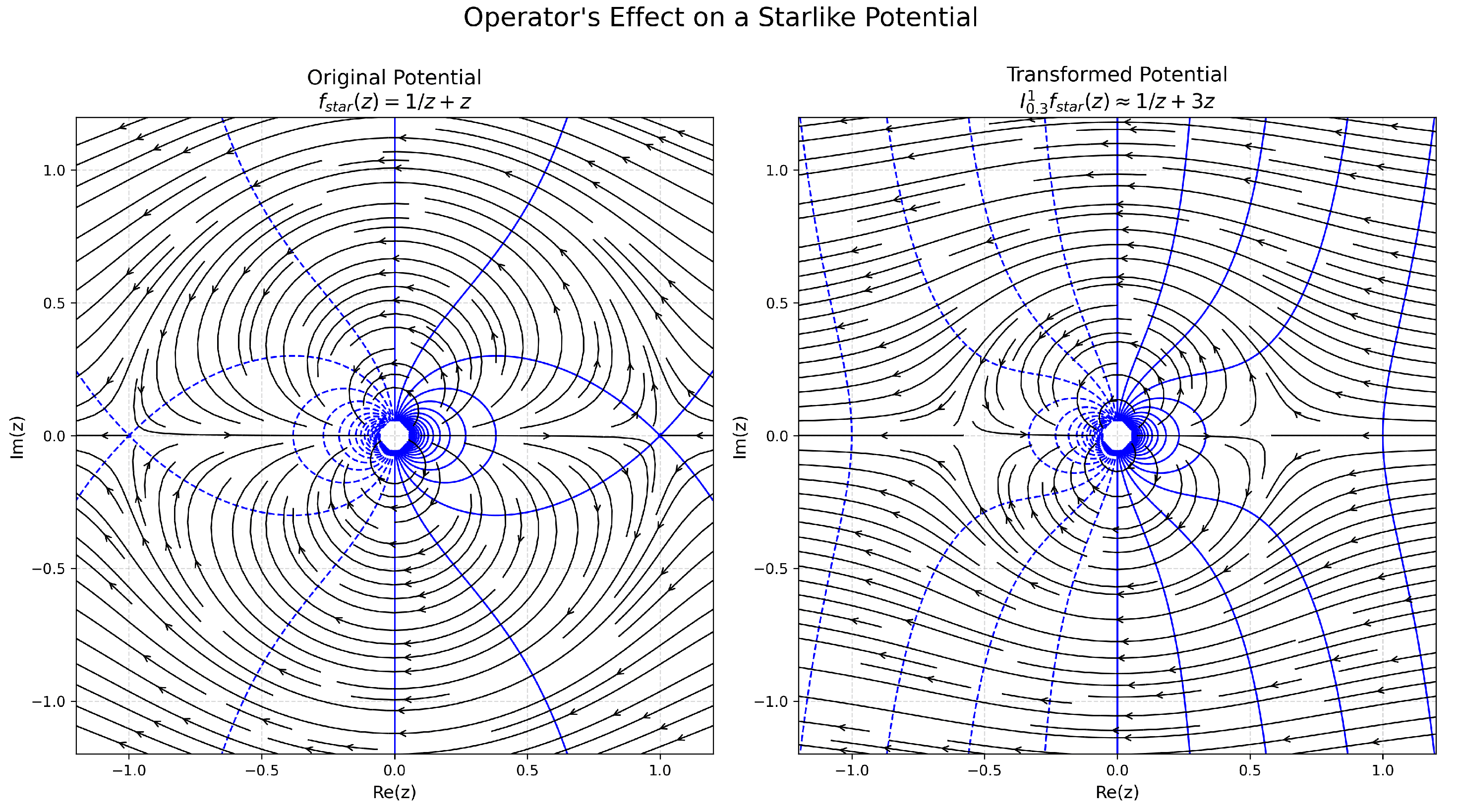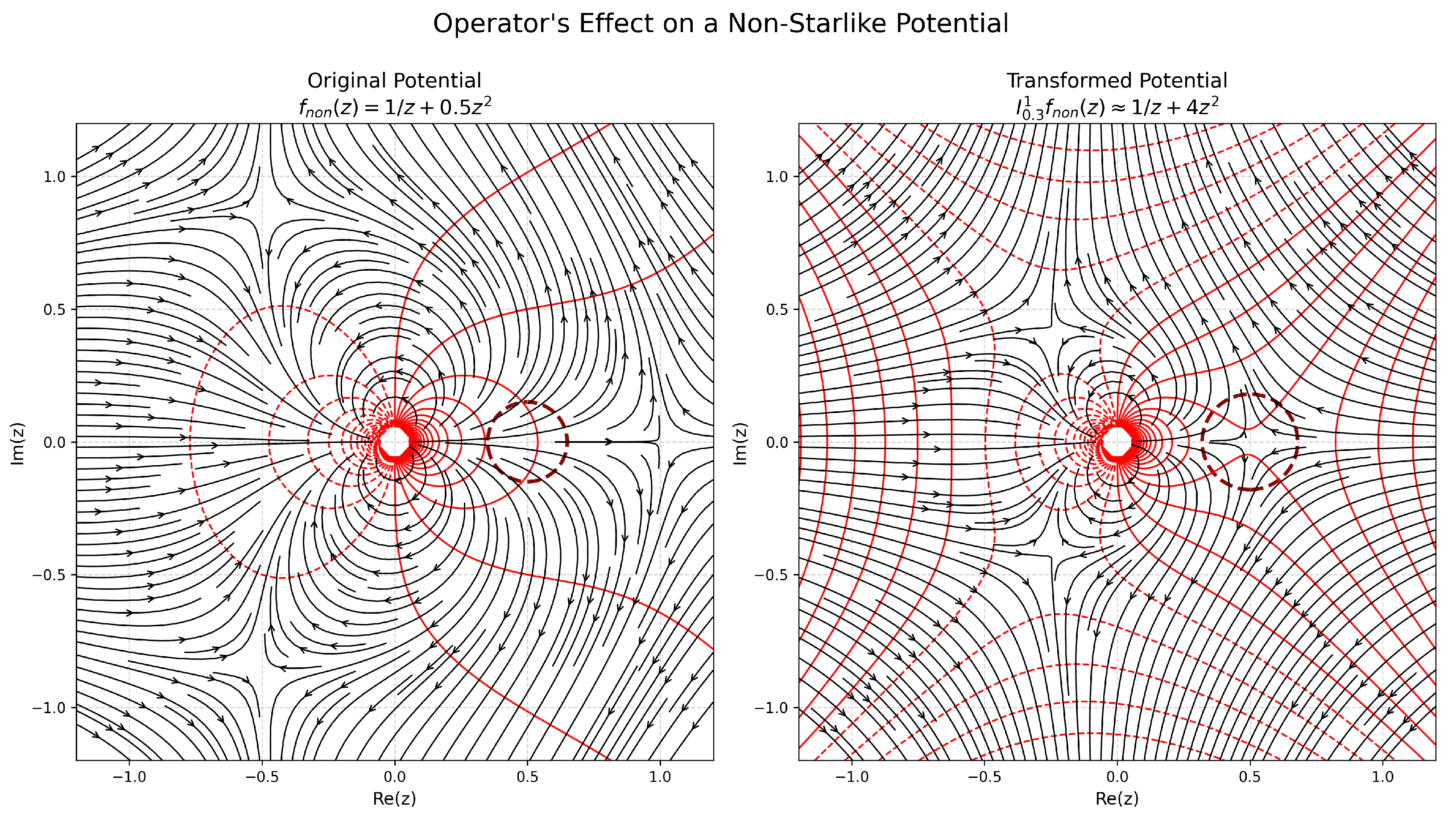Sharp Bounds and Electromagnetic Field Applications for a Class of Meromorphic Functions Introduced by a New Operator
Abstract
1. Introduction
2. Mathematical Preliminaries
- 1.
- ;
- 2.
- ;
- 3.
- .
- 1.
- ;
- 2.
- ;
- 3.
- ;
- 4.
- ;
- 5.
- .
3. Fekete–Szegö Problem
- 1.
- If , then
- 2.
- If , then
- 1.
- If , then
- 2.
- If , then
4. Second Hankel Problem
5. Applications in the Electromagnetic Field
5.1. The Operator as a Field Transformation Kernel
- Multipole Suppression and Field Regularization: We interpret the parameter as a regularization parameter. Its function is based on the operator’s kernel, which includes the damping factor . This term has direct control over the amplitudes of the multipole coefficients in the transformed potential.The mechanism proceeds as follows: When is close to 0, the factor approaches 1 for all k, while the initial multipole moments remain basically unaltered. As approaches 1, the base becomes a small fraction. For higher-order moments (large k), raising this fractional base to a large power reduces the damping factor to an exceedingly small value, thereby suppressing these terms. As a result, geometric damping is most effective at attenuating the high-frequency (large k) components of the potential.This mathematical approach is similar to a low-pass spatial filter. It regularizes the singularity of the field by smoothing the potential, which is physically significant because real-world dispersive media frequently cannot tolerate arbitrarily high spatial frequency fields. We introduce this tunable process as a mathematical model for how environmental factors can limit the spatial complexity of the source field.
- Spectral Redistribution: We interpret the parameter () as spectral order. It provides a technique for redistributing the transformed field’s energy among its multipole components by altering their relative weights. This is achieved by the Gamma function, , in the operator’s kernel.The key characteristic of this term is its super-polynomial growth with k. This means it grows quicker than any simple power, such as and . The value of within the prescribed range tunes this rapid growth. With an increase in from 0 to 1, grows faster with k, increasing the amplitudes of higher-order multipole moments (large k) compared to lower-order ones.Physically, this corresponds to broadening the spatial frequency spectrum of the potential. While the parameter acts as a low-pass filter, the parameter acts as a spectral shaping tool, enhancing the field with finer details and more complex spatial variations. This enables the operator to model phenomena in which an interaction with a medium or structure enhances the high-frequency components of a field.
- The function’s principal part at the origin, the term, represents the potential of a 2D line dipole source [43].
- The analytic part of the function represents a superposed external potential that is regular at the origin.
- : Represents a constant potential offset. It contributes no electric field as .
- : Represents the complex amplitude of a uniform external electric field. The field strength is proportional to , and its direction is determined by .
- : Represents the strength of a quadrupole field, which generates an electric field that increases linearly with distance from the origin, as shown in a field gradient.
5.2. Subordination and Field Geometry Control
- 1.
- Starlike Potential: We begin with
- 2.
- The Non-Starlike Potential: Next, we consider the potential
6. Conclusions
Author Contributions
Funding
Data Availability Statement
Conflicts of Interest
References
- Pommerenke, C. On meromorphic starlike functions. Pac. J. Math. 1963, 13, 221–235. [Google Scholar] [CrossRef]
- Miller, J. Convex meromorphic mapping and related functions. Proc. Am. Math. Soc. 1970, 25, 220–228. [Google Scholar] [CrossRef]
- Mogra, M.L.; Reddy, T.R.; Juneja, O.P. Meromorphic univalent functions with positive coefficients. Bull. Aust. Math. Soc. 1985, 32, 161–176. [Google Scholar] [CrossRef]
- Aouf, M.K. A certain subclass of meromorphic starlike functions with positive coefficients. Rend. Mat. Appl. 1989, 9, 225–235. [Google Scholar]
- Miller, S.S.; Mocanu, P.T. Differential Subordinations: Theory and Applications; Marcel Dekker Inc.: New York, NY, USA, 2000. [Google Scholar]
- Fekete, M.; Szegö, G. Eine Bemerkung über ungerade schlichte Funktionen. J. Lond. Math. Soc. 1933, 8, 85–89. [Google Scholar] [CrossRef]
- Pommerenke, C. Univalent Functions; Vandenhoeck and Ruprecht: Göttingen, Germany, 1975. [Google Scholar]
- Noonan, J.W.; Thomas, D.K. On the second Hankel determinant of a really mean valent functions. Trans. Am. Math. Soc. 1976, 223, 337–346. [Google Scholar]
- Ehrenborg, R. The Hankel determinant of exponential polynomials. Am. Math. Mon. 2000, 107, 557–560. [Google Scholar] [CrossRef]
- Hayami, T.; Owa, S. Generalized Hankel determinant for certain classes. Int. J. Math. Anal. 2010, 4, 2573–2585. [Google Scholar]
- Carathéodory, C. Über den Variabilitätsbereich der Fourier’schen Konstanten von positiven harmonischen Funktionen. Rend. Circ. Mat. Palermo 1911, 32, 193–217. [Google Scholar] [CrossRef]
- Milne-Thomson, L.M. Theoretical Hydrodynamics, 5th ed.; Macmillan: London, UK, 1968. [Google Scholar]
- Kothandaraman, C.P.; Rudramoorthy, R. Fluid Mechanics and Machinery; New Age Publications (Academic): New Delhi, India, 2009. [Google Scholar]
- Mishra, A.K.; Panigrahi, T.; Mishra, R.K. Subordination and inclusion theorems for subclasses of meromorphic functions with applications to electromagnetic cloaking. Math. Comput. Model. 2013, 57, 945–962. [Google Scholar] [CrossRef]
- Zayed, H.M.; Mohammadein, S.A.; Aouf, M.K. Sandwich results of p-valent functions defined by a generalized fractional derivative operator with application to vortex motion. Rev. R. Acad. Cienc. Exactas Fís. Nat. Ser. A Mat. RACSAM 2019, 113, 1499–1514. [Google Scholar] [CrossRef]
- Morais, J.; Zayed, H.M. Applications of differential subordination and superordination theorems to fluid mechanics involving a fractional higher-order integral operator. Alex. Eng. J. 2021, 60, 3901–3914. [Google Scholar] [CrossRef]
- Zill, D.G.; Shanahan, P.D. A First Course in Complex Analysis with Applications, 2nd ed.; Jones and Bartlett Publishers: Sudbury, MA, USA, 2009. [Google Scholar]
- Bulboaca, T. Differential Subordinations and Superordinations, Recent Results; House of Science Book Publisher: Cluj-Napoca, Romania, 2005. [Google Scholar]
- Schwarz, H.A. On some mapping problems. J. Reine Angew. Math. 1869, 70, 105–120. [Google Scholar]
- Silverman, H.; Suchithra, K.; Stephen, B.; Gangadharan, A. Coefficient bounds for certain classes of meromorphic functions. J. Inequal. Appl. 2008, 2008, 931981. [Google Scholar] [CrossRef]
- Mohammed, A.; Darus, M. Bounded coefficient for certain subclass of meromorphic function. In Proceedings of the International Conference on Quality, Productivity and Performance Measurement, Putrajaya, Malaysia, 16–18 November 2009; p. 8. [Google Scholar]
- Reddy, T.R.; Sharma, R.B. Fekete-Szegö inequality for certain subclasses of meromorphic functions. Int. Math. Forum 2010, 5, 3399–3412. [Google Scholar]
- Ali, R.M.; Ravichandran, V. Classes of meromorphic α-convex functions. Taiwan J. Math. 2010, 14, 1479–1490. [Google Scholar] [CrossRef]
- Aouf, M.K. Coefficient results for some classes of meromorphic functions. J. Nat. Sci. Math. 1987, 27, 81–97. [Google Scholar]
- Karunakaran, V. On a class of meromorphic starlike functions in the unit disc. Math. Chron. 1976, 4, 112–121. [Google Scholar]
- Ravichandran, V.; Kumar, S.S.; Subramanian, K.G. Convolution conditions for spirallikeness and convex spirallikeness of certain p-valent meromorphic functions. J. Inequal. Pure Appl. Math. 2004, 5, 7. [Google Scholar]
- Aouf, M.K.; El-Emam, F.Z. Fekete-Szegö problems for certain classes of meromorphic functions involving q-Al-Oboudi differential operator. J. Math. 2022, 2022, 4731417. [Google Scholar] [CrossRef]
- Ruscheweyh, S. New criteria for univalent functions. Proc. Am. Math. Soc. 1975, 49, 109–115. [Google Scholar] [CrossRef]
- Libera, R.J.; Zlotkiewicz, E.J. Coefficient bounds for the inverse of a function with derivative in P. Proc. Am. Math. Soc. 1983, 87, 251–257. [Google Scholar] [CrossRef]
- Abbas, M.I. Existence results and the Ulam stability for fractional differential equations with hybrid proportional Caputo derivatives. J. Nonlinear Funct. Anal. 2020, 2020, 48. [Google Scholar] [CrossRef]
- Atshan, W.G.; Buti, R.H. Fractional calculus of a class of univalent functions with negative coefficients defined by Hadamard product with Rafid operator. Eur. J. Pure Appl. Math. 2011, 4, 162–173. [Google Scholar]
- Abbas, A.F.; Atshan, W.G. New Sandwich-type results of meromorphic multivalent functions defined by Rafid operator. J. Al-Qadisiyah Comput. Sci. Math. 2023, 15, 21–29. [Google Scholar] [CrossRef]
- El-Emam, F.Z. Fuzzy differential subordinations for univalent functions involving Rafid-operator. J. Egypt. Math. Soc. 2024, 32, 1–10. [Google Scholar]
- Aouf, M.K.; Mostafa, A.O.; Al-Quhali, F.Y. Subordinating results for a class of analytic functions defined by Hadamard product and Atshan and Rafid operator. Surv. Math. Appl. 2021, 16, 1–11. [Google Scholar]
- Golmohammadi, M.H.; Najafzadeh, S. Properties of a new subclass of analytic functions associated to Rafid operator and q-derivative. Facta Univ. Ser. Math. Inform. 2021, 36, 179–189. [Google Scholar] [CrossRef]
- Ma, W.C.; Minda, D. A unified treatment of some special classes of univalent functions. In Proceedings of the Conference on Complex Analysis, Tianjin, China, 19–23 June 1992; International Press: Cambridge, MA, USA, 1994. [Google Scholar]
- Duren, P.L. Univalent Functions; Springer: New York, NY, USA, 1983. [Google Scholar]
- Akgül, A. Fekete-Szegö variations for some new classes of analytic functions explained over Poisson and Borel distribution Series. Math. Methods Appl. Sci. 2025, 48, 9241–9252. [Google Scholar] [CrossRef]
- Mostafa, A.O.; El-Hawsh, G.M. Fekete-szegö results for a certain class of meromorphic functions using q-derivative operator. Afr. Mat. 2025, 36, 50. [Google Scholar] [CrossRef]
- Nehari, Z. Conformal Mapping; McGraw-Hill: New York, NY, USA, 1952. [Google Scholar]
- Raza, M.; Riaz, A.; Zaprawa, P. Hankel determinants for starlike functions associated with a cardioid domain. Lith. Math. J. 2025, 65, 368–379. [Google Scholar] [CrossRef]
- Alsoboh, A.; Tayyah, A.S.; Amourah, A.; Al-Maqbali, A.A.; Al Mashrafi, K.; Sasa, T. Hankel determinant estimates for Bi-Bazilevic-Type functions involving q-Fibonacci numbers. Mathematics 2025, 18, 6698. [Google Scholar] [CrossRef]
- Zangwill, A. Modern Electrodynamics; Cambridge University Press: Cambridge, UK, 2013. [Google Scholar]



Disclaimer/Publisher’s Note: The statements, opinions and data contained in all publications are solely those of the individual author(s) and contributor(s) and not of MDPI and/or the editor(s). MDPI and/or the editor(s) disclaim responsibility for any injury to people or property resulting from any ideas, methods, instructions or products referred to in the content. |
© 2025 by the authors. Licensee MDPI, Basel, Switzerland. This article is an open access article distributed under the terms and conditions of the Creative Commons Attribution (CC BY) license (https://creativecommons.org/licenses/by/4.0/).
Share and Cite
Yehia, A.M.; Hashem, A.F.; Madian, S.M.; Tharwat, M.M. Sharp Bounds and Electromagnetic Field Applications for a Class of Meromorphic Functions Introduced by a New Operator. Axioms 2025, 14, 684. https://doi.org/10.3390/axioms14090684
Yehia AM, Hashem AF, Madian SM, Tharwat MM. Sharp Bounds and Electromagnetic Field Applications for a Class of Meromorphic Functions Introduced by a New Operator. Axioms. 2025; 14(9):684. https://doi.org/10.3390/axioms14090684
Chicago/Turabian StyleYehia, Abdelrahman M., Atef F. Hashem, Samar M. Madian, and Mohammed M. Tharwat. 2025. "Sharp Bounds and Electromagnetic Field Applications for a Class of Meromorphic Functions Introduced by a New Operator" Axioms 14, no. 9: 684. https://doi.org/10.3390/axioms14090684
APA StyleYehia, A. M., Hashem, A. F., Madian, S. M., & Tharwat, M. M. (2025). Sharp Bounds and Electromagnetic Field Applications for a Class of Meromorphic Functions Introduced by a New Operator. Axioms, 14(9), 684. https://doi.org/10.3390/axioms14090684





